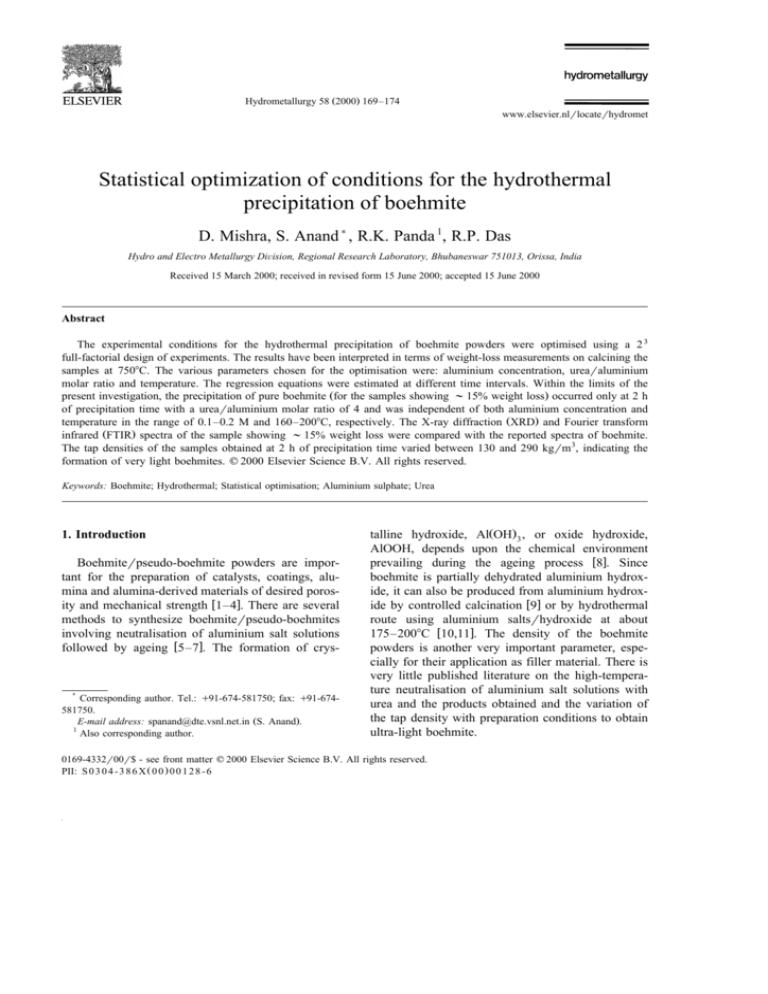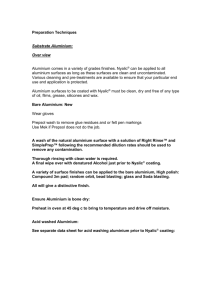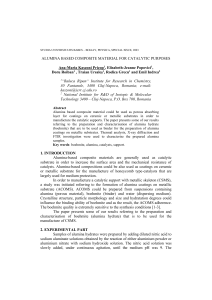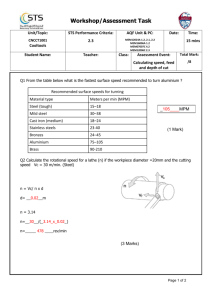
Hydrometallurgy 58 Ž2000. 169–174
www.elsevier.nlrlocaterhydromet
Statistical optimization of conditions for the hydrothermal
precipitation of boehmite
D. Mishra, S. Anand ) , R.K. Panda 1, R.P. Das
Hydro and Electro Metallurgy DiÕision, Regional Research Laboratory, Bhubaneswar 751013, Orissa, India
Received 15 March 2000; received in revised form 15 June 2000; accepted 15 June 2000
Abstract
The experimental conditions for the hydrothermal precipitation of boehmite powders were optimised using a 2 3
full-factorial design of experiments. The results have been interpreted in terms of weight-loss measurements on calcining the
samples at 7508C. The various parameters chosen for the optimisation were: aluminium concentration, urearaluminium
molar ratio and temperature. The regression equations were estimated at different time intervals. Within the limits of the
present investigation, the precipitation of pure boehmite Žfor the samples showing ; 15% weight loss. occurred only at 2 h
of precipitation time with a urearaluminium molar ratio of 4 and was independent of both aluminium concentration and
temperature in the range of 0.1–0.2 M and 160–2008C, respectively. The X-ray diffraction ŽXRD. and Fourier transform
infrared ŽFTIR. spectra of the sample showing ; 15% weight loss were compared with the reported spectra of boehmite.
The tap densities of the samples obtained at 2 h of precipitation time varied between 130 and 290 kgrm3, indicating the
formation of very light boehmites. q 2000 Elsevier Science B.V. All rights reserved.
Keywords: Boehmite; Hydrothermal; Statistical optimisation; Aluminium sulphate; Urea
1. Introduction
Boehmiterpseudo-boehmite powders are important for the preparation of catalysts, coatings, alumina and alumina-derived materials of desired porosity and mechanical strength w1–4x. There are several
methods to synthesize boehmiterpseudo-boehmites
involving neutralisation of aluminium salt solutions
followed by ageing w5–7x. The formation of crys-
)
Corresponding author. Tel.: q91-674-581750; fax: q91-674581750.
E-mail address: spanand@dte.vsnl.net.in ŽS. Anand..
1
Also corresponding author.
talline hydroxide, AlŽOH. 3 , or oxide hydroxide,
AlOOH, depends upon the chemical environment
prevailing during the ageing process w8x. Since
boehmite is partially dehydrated aluminium hydroxide, it can also be produced from aluminium hydroxide by controlled calcination w9x or by hydrothermal
route using aluminium saltsrhydroxide at about
175–2008C w10,11x. The density of the boehmite
powders is another very important parameter, especially for their application as filler material. There is
very little published literature on the high-temperature neutralisation of aluminium salt solutions with
urea and the products obtained and the variation of
the tap density with preparation conditions to obtain
ultra-light boehmite.
0169-4332r00r$ - see front matter q 2000 Elsevier Science B.V. All rights reserved.
PII: S 0 3 0 4 - 3 8 6 X Ž 0 0 . 0 0 1 2 8 - 6
170
D. Mishra et al.r Hydrometallurgy 58 (2000) 169–174
In our earlier study, several samples of nonstoichiometric boehmite ŽAl 2 O 3 x H 2 O, 1 - x ) 1.5.
were prepared hydrothermally at various temperatures in the range of 160–2208C from aluminium
nitrate solutions using urea as the neutralising agent
w12x. The other parameters such as aluminium concentration and urearAl ratio may also affect the
precipitation of boehmite. With a view to statistically
optimise the precipitation conditions, a 2 3 full-factorial design of experiments was chosen. The significant effects of linear and interaction parameters have
been determined in terms of % weight loss at 7508C.
The effects of precipitation parameters on the tap
density have also been quantified. Further, the characterisation of typical samples using X-ray diffraction ŽXRD. and Fourier transform infrared ŽFTIR.
techniques are discussed to confirm the formation of
boehmite g-AlOOH.
2. Experimental
The precipitation experiments were carried out in
a closed 7.56-L capacity reactor ŽParr Model 4552.
having temperature controller, agitation and sampling facilities. The required amounts of aluminium
sulphate, urea and distilled water were transferred to
the reactor. The contents were then heated to different temperatures Ž1608C, 1808C, 2008C. and maintained at those temperatures for the required period.
The stirring rate was kept constant at 400 miny1 and
the samples were collected as and when required.
The products were cooled to room temperature, filtered, washed with distilled water until free of SO42y
Žtested qualitatively with barium chloride. w13x. The
samples were dried overnight in an air oven maintained at 90–958C. All the reagents and chemicals
used were of analytical grade.
The weight-loss measurements were done using
platinum crucibles, and weights were obtained using
an electronic digital balance ŽAFCOSET ER-180A.
with an accuracy within "0.1 mg. Some of the
measurements were repeated several times in order
to ascertain the reproducibility.
The XRD pattern of a typical sample was obtained with a Phillips powder diffractometer model
PW 1710 in a range of 6–708 Ž2 u . at a scanning rate
of 28rmin using a Ni-filtered Cu target. The IR
spectrum of the sample was obtained on a Perkin
Elmer FTIR P-500 spectrophotometer by the KBrpellet method.
The tap density was measured by filling a known
weight of the samples in a 10-mL graduated cylinder
and tapping it until constant volume was obtained.
3. Results and discussion
The experiments were designed according to a 2 3
full-factorial matrix w14x with the view of optimizing
the precipitation conditions for boehmite. The three
variables selected for this purpose were: temperature,
aluminium concentration and urearAl mole ratio.
The lower and upper levels of temperature were
fixed as 1608C and 2008C, respectively. The lower
and upper levels of aluminium concentration were
fixed as 0.1 and 0.2 M while the lower and upper
levels of urearAl molar ratio were fixed as 2 and 4,
respectively. The base-level conditions were: temperature 1808C, aluminium concentration 0.15 M and
urearAl ratio 3.
The various chemical reactions for the formation
of boehmite will be:
Al 2 Ž SO4 . 3 q 3NH 2 –CO–NH 2 q Ž x q 6 . H 2 O
™ Al O P x H O q 3Ž NH . SO q 3CO
Al Ž SO . q 4NH –CO–NH q Ž x q 7 . H O
™ Al O P x H O q 3Ž NH . SO q 2NH
2
2
3
2
4 3
2
4 2
2
3
2
4
2
4 2
2
Ž 1.
2
4
3
q 4CO 2
Ž 2.
Al 2 Ž SO4 . 3 q 7NH 2 –CO–NH 2 q Ž x q 14 . H 2 O
™ Al O P x H O q 3Ž NH . SO
2
3
2
4 2
q 4 Ž NH 4 . 2 CO 3 q 3CO 2
4
Ž 3.
Depending on the urearAl ratio the products
would vary. Formation of carbon dioxide and ammonia was confirmed qualitatively w13x. The overall
system pressure exceeded the expected vapor pressure of water at precipitation temperatures confirming the evolution of gases. Similar observations were
also made in our earlier studyw12x.
On calcination at 7508C, both boehmite and
pseudo-boehmite samples would lose water and the
extent of weight loss would depend on the value of x
in Al 2 O 3 P x H 2 O. For pure boehmite, the theoretical
percentage weight loss should be 15%.
D. Mishra et al.r Hydrometallurgy 58 (2000) 169–174
The three-dimensional presentation of results obtained from the percentage weight loss on calcining
the 0h, 1h and 2h samples Žprepared under different
experimental conditions as per 2 3 full-factorial design. at 7508C for 2 h is given in Fig. 1.
The percentage weight loss can be expressed by
the full regression equation as w14x:
% wt. loss s b 0 q b 1 X 1 q b 2 X 2 q b 3 X 3 q b 12 X 1 X 2
q b 23 X 2 X 3 q b 31 X 3 X 1 q b 123 X 1 X 2 X 3
Ž 4.
where % wt. loss represents the percentage loss of
weight at 7508C for the boehmite sample. The linear
coefficients are b 1 , b 2 , b 3 , the interaction coefficients are b 12 , b 23 , b 31 and b 123 is the third-order
171
interaction term. X 1 , X 2 and X 3 are the dimensionless coded factors for the contributions of temperature, aluminium concentration and urearAl ratio,
respectively. On evaluating the interaction and the
linear coefficients by the standard procedure and
testing for significance by Student’s t-test w14x, the
regression equation for the percentage weight loss
for the 0 h samples becomes:
% wt. loss Ž0 h . s 22.78 q 2.406 X 2 y 1.791 X 3
y 1.791 X 2 X 3
Ž 5.
The adequacy of Eq. Ž5. was tested by Fisher’s
test to find out how it fits the observations. The
variance ratio F1 w14x was calculated to be 3.36 for
% wt. loss Ž0 h. . The tabulated value of Fisher’s F for
Fig. 1. Cubical presentation of results obtained for % weight loss and tap density using 2 3 factorial design of experiments for the
hydrothermal precipitation of boehmite.
172
D. Mishra et al.r Hydrometallurgy 58 (2000) 169–174
a s 0.05 Ž95% confidence level. and n 1 = n 2 s 4 =
2 df is 19.3, Ž n 1 is evaluated by subtracting the
number of significant coefficients in the regression
equation from the total number of observations, and
n 2 is one less than the number of repeat tests for the
base levels. In the present study, three repeat experiments were carried out at base level.. Since F1 FŽ1y a .Ž n 1 , n 2 ., therefore, the estimated regression
equation Ž5. would fit the experimental data adequately w14x.
Following the same procedure, the regression
equations for 1 and 2 h of precipitation times were
estimated as:
% wt. loss Ž1h . s 16.48 y 1.034 X 3
Ž 6.
% wt. loss Ž2 h . s 15.76 y 0.717X 3
Ž 7.
The variance ratio w14x was calculated to be 2.51
for Eq. Ž6. and 1.52 for Eq. Ž7.. The tabulated value
of Fisher’s F for these two equations for a s 0.05
Ž95% confidence level. and n 1 = n 2 s 6 = 2 df is
19.3. Since variance ratios - FŽ1y a .Ž n 1 , n 2 ., both for
Eqs. Ž6. and Ž7., these equations would fit the experimental data adequately w14x.
The observations made from the regression equations Ž5., Ž6. and Ž7. are as follows.
Ži. Irrespective of the precipitation time, the linear
or interaction coefficients for the temperature remain
insignificant in the studied range of 160–2008C.
Žii. On attainment of the precipitation temperature
Žreferring to 0 h., the percentage weight loss increases with the increase of aluminium concentration
and decreases with the increase of the urearAl ratio
while the simultaneous increase of the aluminium
concentration and the urearAl ratio will result in
decrease of weight loss.
Žiii. The decrease in weight loss indicates the
formation of boehmite, and as the weight loss approaches 15% formation of pure boehmite is indicated. With the increase in precipitation time to 1 or
2 h, only the urearAl ratio shows a significant linear
Fig. 2. Typical XRD pattern of the sample prepared under the following conditions: temp. 2008C, Al concentration 0.1M, urearAl ratio 4
and time 2 h Žpoint 6 of cube..
D. Mishra et al.r Hydrometallurgy 58 (2000) 169–174
173
Fig. 3. Typical IR spectra of the sample prepared under the same conditions given in Fig. 2.
coefficient. The numerical value of the linear coefficient decreases with the increase of time.
Živ. Only at the 2-h precipitation time does the
percentage weight loss approach 15% with a urearAl
ratio of 4.
Žv. The surface represented by the experimental
conditions of Ž5., Ž6., Ž7. and Ž8. in Fig. 1 shows the
formation of boehmite g-AlOOH as weight loss is
; 15%.
Tap density was determined only for the 2-h
samples and the results are given in Fig. 1 Žshown as
d2h values.. The regression equation was estimated
in a similar way as for the percentage weight loss
and is given below:
Tap densitys 0.204 q 0.009 X 1 q 0.041 X 3
y 0.013 X 2 X 3 q 0.25 X 1 X 3
Ž 8.
It is observed that the tap density decreases only
with the simultaneous increase of the aluminium
concentration and of the urearAl ratio. Both the
temperature and the urearAl ratio show significant
linear and interaction coefficients. The variance ratio
was estimated to be 0.205. The tap density varied
between 130 and 290 kgrm3.
The surface presented by the coordinates Ž5., Ž6.,
Ž7. and Ž8. at 2-h retention time shows the formation
of pure boehmite. The XRD patterns and IR spectra
of these samples were identical, and the XRD of a
typical sample Žexperiment 6 of Fig. 1. is given in
Fig. 2. The pattern shows four major lines at d
values of 6.20, 3.16, 2.35 and 1.85 A0 . These lines
are characteristic of boehmite w15x.
The typical FTIR spectrum of the same sample is
shown in Fig. 3. The two broad lines at ; 3300 and
3100 cmy1 can be assigned to the –OH stretching
vibrations of the H 2 OrOH groups of boehmite w16x.
The corresponding bending vibrations at 1160 and
1060 cmy1 are also in agreement with the reported
value of boehmite. The Al–O stretching vibrations at
740 and 620 cmy1 and the Al–O bending mode at
480 cmy1 are also similar to the reported value for
boehmite w16x.
4. Conclusions
In conclusion, it can be stated that optimisation of
the preparation conditions for boehmite using 2 3
full-factorial design of experiments gave a response
surface for the formation of pure boehmite g-AlOOH.
The variables chosen were: temperature, aluminium
concentration and urearAl ratio. The design matrix
under the studied range of variables showed the best
conditions for boehmite precipitation as: temperature
160–2008C, aluminium concentration 0.1–0.2 M,
time 2 h, urearAl molar ratio 4. Under the experimental conditions of the present study, the tap density of the samples for 2-h precipitation time varied
between 130 and 290 kgrm3. The XRD and FTIR
spectra of the sample showing ; 15% weight loss
are found to be in agreement with the reported
spectra of boehmite.
Acknowledgements
The authors are thankful to the Director, Regional
Research Laboratory, for his kind permission to publish this paper.
174
D. Mishra et al.r Hydrometallurgy 58 (2000) 169–174
References
w1x B.E. Yoldas, Am. Ceram. Soc. Bull. 54 Ž1975. 289.
w2x D.L. Trimn, A. Stanislaus, Appl. Catal. 21 Ž1986. 215.
w3x H.L. Zobowa, K. Becker, H.P. Hennig, U. Kretzschmar, M.
Naock, U. Steinike, Chem. Tech. 41 Ž9. Ž1989. 387.
w4x K. Strenge, U. Bollmann, Colloids Surf. 57 Ž1991. 139.
w5x W.H. Gitzen, Am. Ceram. Soc. Ž1970. Columbus, OH.
w6x K.P. Prodromou, A.S. Povlatou-Ve, Clays Clay Miner. 43 Ž1.
Ž1995. 111.
w7x E. Morgado Jr, Y.L. Lam, F.L. Nazar, J. Colloid Interface
Sci. 188 Ž1997. 257.
w8x K. Wefers, C. Misra, Alcoa Tech. Paper 19, Alcoa Laboratories, 1987.
w9x M.K.B. Day, V.J. Hill, J. Phys. Colloid Chem. 57 Ž1953.
946.
w10x M. Pyzalski, J. Iwanciw, Light Met. Ž1994. 107.
w11x A.P. Buining, C. Pathmamanoharan, M. Bosboom, J. Ben, H.
Jansen, H.N.W. Lekkerkerker, J. Am. Ceram. Soc. 73 Ž8.
Ž1990. 2385.
w12x D. Mishra, S. Anand, R.K. Panda, R.P. Das, Mater. Lett. 42
Ž1–2. Ž2000. 38.
w13x G. Svehla, Vogels’ Qualitative Inorganic Analysis, 6th edn.,
Orient Longman, 1979, pp. 146, 150, 182.
w14x S. Akhnazarva, V. Kafarov, Experimental Optimisation in
Chemistry and Chemical Engineering, Mir, Moscow, 1982,
pp. 151–158, 300, 303.
w15x Joint Committee on Powder Diffraction Standard ŽJCPDS.,
International Center For Diffraction Data, Swathmore, PA,
File 10-425.
w16x T. Assih, A. Ayral, M. Abenoza, J. Phalippou, J. Mater. Sci.
23 Ž1988. 3226.










